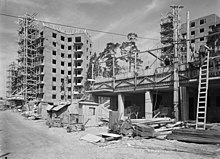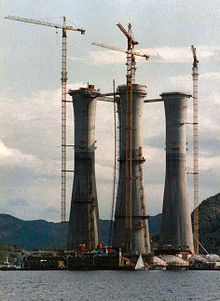Term: Slip forming
History:
– Slip forming technique used in early 20th century for silos and grain elevators
– James MacDonald pioneered slip form concrete construction
– MacDonald patented concept of circular bins in clusters in 1907
– MacDonald patented device for moving and elevating concrete form in 1917
– Slip forming used for AT&T Long Lines towers in 1947-1950
Silos:
– MacDonald Engineering constructed over 40 concrete towers using slip-form method
– Towers up to 58m tall for AT&T Long Lines microwave relay stations
– Landmark Hotel & Casino in Las Vegas built in 1961 with slip form concrete
– Slip forming technique utilized worldwide by MacDonald Engineering
– Coal silos and grain silos commonly constructed using slip forming
Residential and commercial building:
– Slip forming introduced to residential and commercial buildings in 1950s in Sweden
– Bygging developed first hydraulic hijacks for slip forming in 1944
– Slip forming used in high-rise buildings in the USA from late 1960s
– Slip forming technique pioneered by Bygging in Västertorp, Sweden
– Slip forming adapted to various structures like mining head frames and high-rise office building cores
References:
– Slip forming technique introduced in Baltimore according to Concrete Construction Engineering Handbook
– James MacDonald’s paper on moving forms for reinforced concrete storage bins
– Slip forming used for construction of CN Tower in Toronto
– Slip forming technique referenced in Washington Post in 1971
– Slip forming technique utilized to build the Shard London Bridge tower in 2010
External links:
– Slip-Form Construction Time Lapse video from The Dalles, Oregon
– MacDonald Engineering’s slip form concrete grain silos video
– Additional information on slip forming technique on the Slipform website
Slip forming, continuous poured, continuously formed, or slipform construction is a construction method in which concrete is poured into a continuously moving form. Slip forming is used for tall structures (such as bridges, towers, buildings, and dams), as well as horizontal structures, such as roadways. Slipforming enables continuous, non-interrupted, cast-in-place "flawless" (i.e. no joints) concrete structures that have performance characteristics superior to those of piecewise construction using discrete form elements. Slip forming relies on the quick-setting properties of concrete, and requires a balance between quick-setting capacity and workability. Concrete needs to be workable enough to be placed into the form and consolidated (via vibration), yet quick-setting enough to emerge from the form with strength. This strength is needed because the freshly set concrete must not only permit the form to "slip" by the concrete without disturbing it, but also support the pressure of the new concrete and resist collapse caused by the vibration of the compaction machinery.




In vertical slip forming the concrete form may be surrounded by a platform on which workers stand, placing steel reinforcing rods into the concrete and ensuring a smooth pour. Together, the concrete form and working platform are raised by means of hydraulic jacks. Generally, the slipform rises at a rate which permits the concrete to harden by the time it emerges from the bottom of the form.
In horizontal slip forming for pavement and traffic separation walls, concrete is laid down, vibrated, worked, and settled in place while the form itself slowly moves ahead. This method was initially devised and utilized in Interstate Highway construction initiated by the Eisenhower administration during the 1950s.

